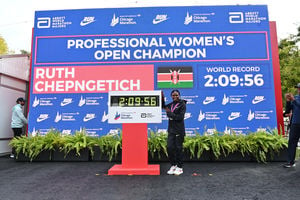World U20 top guns that rose fast and faded in a flash

Silver medallist Kenya's Daniel Simiu Ebenyo (right) and bronze medallist Kenya's Kibiwott Kandie (left) celebrate with teammate Kenya's Edward Zakayo Pingua after the men's 10,000m final athletics event at the Alexander Stadium, in Birmingham on day five of the Commonwealth Games in Birmingham, central England, on August 2, 2022.
What you need to know:
- Like lightning, a legion of Kenyan athletes staged brilliant performances in junior ranks and disappeared at the same world record pace.
They came, conquered, and simply disappeared in a flash.
Their athletics scripts seemed like they were straight from heaven.
Like Lake Maracaibo in Venezuela–which was entered into the Guinness Book of World Records for its “highest concentration of lightning” each year –some Kenyan athletics stars hit the world stage at under 20 level in track competitions and faded away like lightning.
They worked hard in school games and nursed huge ambitions in their athletics careers –longing to emulate Kenya’s most consistent athletes like former world marathon record holder Eliud Kipchoge, 2018 London Marathon winner Vivian Cheruiyot, and two-time world marathon champion Edna Kiplagat.
These big shots produced impressive performances that would be fit for an Oscar award. But, oops! Their lofty dreams crash-landed before or immediately after they graduated to senior ranks.
A study by World Athletics shows that many athletes fall by the wayside never to graduate to senior cadre. Only 22 per cent of the finalists at the previous World Under 18 championships carried on to the senior level.
It proves how difficult it is to juggle studies, social life, and training at a young age and how this can hinder young athletes from aiming for the top spots.
From 2012 Olympic 800m bronze medalist Timothy Kitum, former world junior 3,000m steeplechase record holder Raymond Yator, 2013 world cross country champion Japhet Korir, 2004 world junior 3,000m steeplechase champion Gladys Kemboi (first Kenyan woman to win gold in steeplechase) and 2006 world cross country junior silver medalist Mercy Kosgei; the record-breaking machines left the athletics world at their young ages in awe.
Kitum comes from Elgeyo Marakwet and saw stars shooting up to global fame and worked his way up to ascend to the pinnacle of the 800m race like a rocket!
He won a two-lap race bronze at the World Under 18 championships in Lille, France, in 2011, and silver at the 2012 World Under 20 championships in Barcelona, Spain, before wrapping up his illustrious career with a bronze at the London Olympic Games.
Leonard Kosencha, another 800m ace who was billed to fit in world 800m record holder David Rudisha’s shoes, also disappeared off the radar after storming to a jaw-dropping 1:44.08 mark –championship record –at the World U18 Championships in Lille, France, in 2011.
A similar script reads for 1998 Commonwealth Games 800m champion Japhet Kimutai, 2016 Olympian Alfred Kipketer, and 2003 World U18 champion Bernard Kapting’ei.
After staging good shows in Lille (World U18) and 2012 Barcelona (World U20) in 1500m, Jonathan Kiplimo Sawe, 2006 World U20 1500m champion Remmy Limo, and 2008 World U18 1500m champion Sammary Cherotich and 2009 World U18 1500m champion Nelly Jebet faded to oblivion.
Former World U20 3,000m record holder Raymond Yator, former World U18 and U20 champion Ronald Kipchumba, 2006 World U20 silver medalist Bisluke Kipkorir, 2000 World U20 champion David Chemweno and former African Games champion Willy Komen –the cohort from steeplechase region of Marakwet –did not live up to the maxim: 3,000m steeplechase is a race ‘Made in Kenya for Kenyans.’
Yator and Kipchumba are best remembered for clearing the water jump without stepping on the water. World U20 bronze medalist Patrick Terer ‘Mtu wa Nguvu’ is also in the mix.
Gladys Kemboi and former World U18 silver medalist Lilian Chemweno, other stars from the Marakwet steeplechase goldmine, are among the water and barriers race big shots that ran out of gas at the senior cadre. Former World U20 3,000m steeplechase record holder Caroline Tuikong and 2008 World U20 medalist Christine Muyanga could not take the heat at the senior level.
Japhet Korir, the 2003 world cross country champion, stands out among Kenya’s long-distance talents who did maintain tempo at the senior competitions.
Others include World U18 3000m champion Daniel Malel Sitonik, World U20 5000m champion Edward Zakayo, 2011 world cross country u20 bronze medalist Patrick Mutunga, Africa 5000m champion Moses Mukono, Africa U20 10,000m bronze medalist Elvis Cheboi and 2009 national cross country U18 champion John Kemboi. Mercy Kosgei, the 2006 world cross country u20 silver medalist and 2011 world u18 3000m silver medalist Zipporah Wanjiru also failed to sparkle at the top level.
These top talents form a growing list of athletes who excel in the junior ranks and fail to advance to the elite ranks. Most of them –especially those who serve in the uniformed forces retreat to prison service camps, army barracks, and police stations to work. Some female athletes become housewives while a majority take up farming and business. Few of them get back to school to focus on academics while others live in abject poverty.
The upshot? Moses Kiptanui, the three-time world 3000m steeplechase champion, says the reasons why these athletes shot to the top and disappeared within a short time are diverse.
“I am not quite sure but it needs a lot of research. What I know is that age matters. For an athlete to step up to a marathon must be over 20 years old.
“Again, the way an athlete gets exposed to training matters a lot. The kind of training the athlete undergoes and the way he pushes himself is critical. Most athletes burn out.
“There is the issue of lifestyle. Athletics demand a high level of discipline and mental strength,” said Kiptanui.
And Bro Colm O’Connell, who has been coaching Kenyan athletes at St Patrick’s High School Iten since 1976, concurs with Kiptanui.
“Athletes make huge sacrifices in terms of discipline and commitment to reach the top level. In most cases, few of them manage it well. Successful athletes take the sport with passion.
“A majority of them want to make money, accumulate wealth and lose motivation. That’s why they cannot be consistent.
“Some athletes are pushed very hard in training while at the youth and junior level. And rising to the highest level is demanding, especially under difficult conditions. So, they burnt out early,” said O’Connell.
Barnaba Korir, the AK youth development chairman, said injuries affected some of them. “Injuries ruled some of the athletes like Timothy Kitum. We tried to treat him but did not respond. Other cases remain isolated; could they have presented false documents regarding their age?
“A majority of them could not afford to manage fame. There is a need for a close-knit working relationship between the Ministry of Sports and Education and come up with lessons on sports psychology in our schools’ curriculum. In this case, AK will midwife the process,” said Korir.
It now remains to be seen if the stars from the just concluded World Under 20 Athletics Championships in Lima, Peru, would transit to seniors with the same rhythm even as the global stage gears for the 2026 World U20 Championships in Los Angeles, USA.




